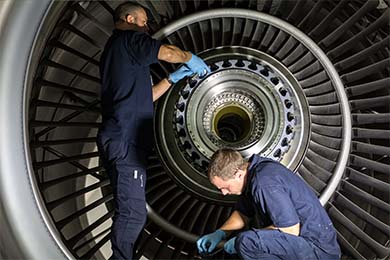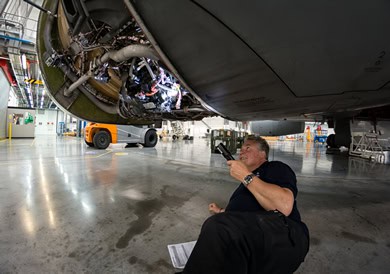Maintenance
Our service enables and underpins the safe and reliable operation of Voyager. Through our aircraft delivery, flight operations, engineering and training programmes, AirTanker gets Voyager flying safely.
Our responsibility
Our maintenance operation plays a vital role in the safe and reliable operation of the RAF’s Voyager fleet. Under the Voyager contract we are responsible not only for delivering aircraft but also for the service and support required to keep the fleet flying through to 2035 and beyond.
To do this we run a complex engineering service that is guided by rigorous industry standards for safety and performance in military and civil aviation.
Voyager’s major maintenance programmes are carried out to Civil Aviation Authority regulations. Civilian’s, RAF engineers and Sponsored Reservists work side by side. All our certifying engineers, whether civilian or RAF embedded, hold an individual Part 66 licence.
We are responsible for all aspects of maintenance from planning through to completion. At RAF Brize Norton we have purpose-built infrastructure that includes a two-bay hangar, which is the focal point for maintenance.

How we work
There are two main processes and approvals that we follow. They are Part CAMO and Part 145. Together, they govern how we plan, carry out and verify every maintenance task we undertake.
Part CAMO
This is the EASA regulation that all airlines registered in Europe must adhere to. It governs how to maintain the continued airworthiness (serviceability) of their aircraft.
CAMO covers the planning and management oversight of all engineering activities:
Planning all maintenance activities on the aircraft. Some of this work is defined by the aircraft manufacturer, while some requirements are defined internally. We must determine the best time and place for the maintenance to be carried out. We also produce a Workpack that contains all the tasks and ensuring all parts and materials needed are in place.
Review of documentation after work is completed. This includes the initial review to ensure that the work has been correctly certified by the maintenance provider (Part 145). It also covers re-planning any repeat tasks and a full review for accuracy of the paperwork and computerised record keeping.
Technical support and projects. This covers the main day-to-day technical link between CAMO the Part 145 and the flight crew. There is also longer term and more in-depth technical assistance to the Part 145 organisation and any liaison needed with the aircraft manufacturer. We store and share with the Part 145 team the data and manuals needed to carry out maintenance on the aircraft. We also have responsibility to manage all projects and modifications to the aircraft away from its standard build.


Part 145
This is the EASA regulation that all aircraft maintenance providers maintaining aircraft belonging to airlines registered in Europe must follow.
It covers any physical servicing, maintaining, repairing and modifying activities carried out:
Line Maintenance. This is the day-to-day higher level maintenance of the aircraft to ensure it remains operational. It includes carrying out specific checks on the aircraft before and after flight, each day and every week as well as rectifying any defects. When needed, engineers travel down route to maintain the aircraft at its various destinations.
Base Maintenance. This is the longer term and more in-depth maintenance of the aircraft. Work includes more detailed testing, inspecting and disassembly of the aircraft and systems. It also involves modifications to the aircraft and replacement of major components such as the engines. The work is conducted in the hangar.
Logistics and Stores. We manage all parts used on the aircraft or for maintenance. This covers receiving, processing, storing and issuing parts. It also includes transporting parts to other locations and the return of unused or unserviceable parts. As well as operating from the hangar, remote logistics and stores are maintained wherever an aircraft operates from.
Although not mandatory, most of our civilian engineers are also RAF Reserves. This gives the RAF greater experience and scope to deploy engineering teams down route to support the aircraft.
Our engineering service also uses the latest secure communications technologies. We can connect our deployed mechanical and electronics specialists in real time with the team at RAF Brize Norton.


